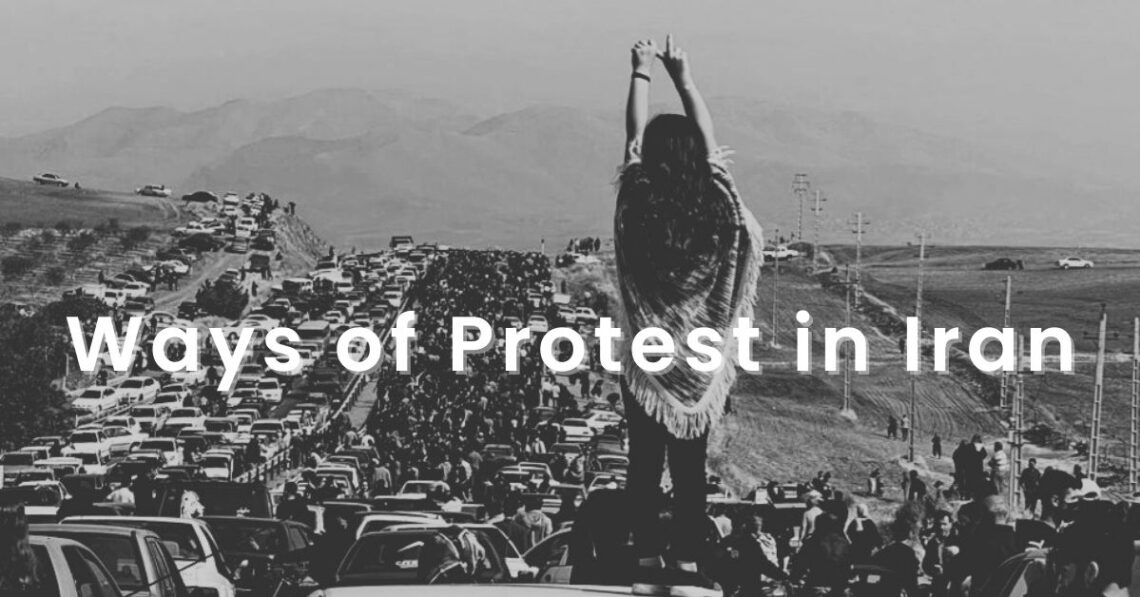
Ways of Protest in Iran
The anti-governmental protests are still going on in Iran. They are being crushed harshly, especially in Kurdistan and Baluchistan. While in Tehran and major cities protesters face tear gas, and are being severely beaten by the police and are being shot pellets, in Kurdistan and Baluchistan people are being shot dead in protests. Almost every day brings new victims – from protesters who are being killed or injured by the police to artists and activists that are being detained by the police.
When I say ‘a protest’, you probably think of people in the streets shouting out slogans. However, in Iran protests have gone much further from the streets into peoples` everyday lives. And in this post, I have gathered all types of protest that I have come across in Iran.
Street Protests
The 3 basic ways of protests in Iran are street protests, strikes and sit-in protests (the latter one has a centuries-long history in Iran, by the way).
That`s true that on daily basis protests occur in the streets inside cities, but when there is an occasion (and what I mean by it is a funeral of a victim of the protests or the 40th day after death of a victim), masses of people gather at the cemetery and beside honoring the memory of the departed, chant anti-governmental slogans. One of the biggest protests occurred on the 40th day since Mahsa Amini`s death when the whole city went towards the cemetery out of town to mourn for her. The police blocked the road preventing them to come through but they found another way. The government didn`t announce an official day of mourning (that is a tradition in Iran and probably in many other countries around the globe), but many Iranians wore black to show that they remember Mahsa Amini and her tragic death.
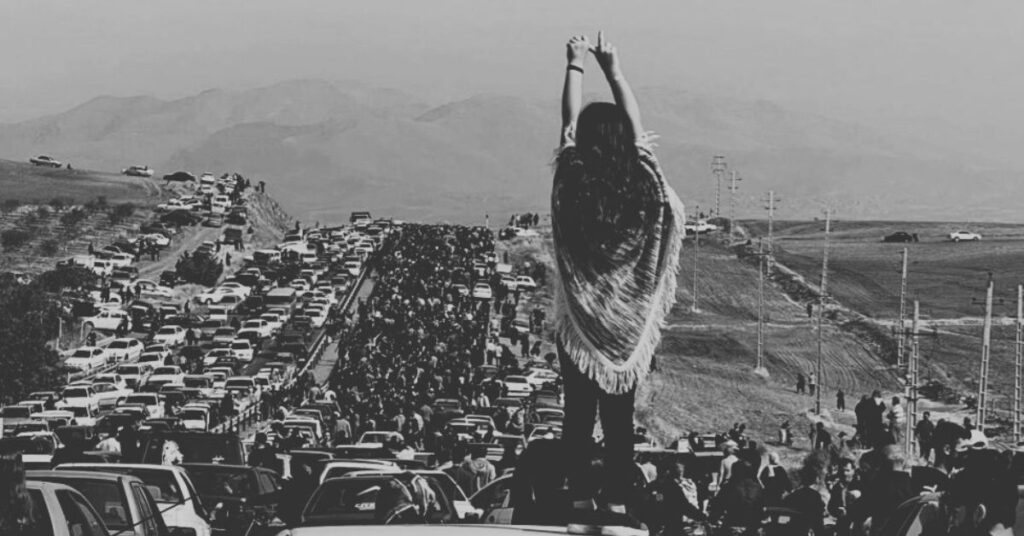
Strikes
A strike was one of the first instruments used by protesters. It started with Saqqez, hometown to Mahsa Amini, where shops (including the bazaar that is the heart of any Iranian city) closed down right after her death. Quite soon the strike spread onto oil companies, then a few factories joined in. Strikes start and continue for a day or two every now and then in different parts of Iran. In Tehran the Grand Bazaar closed down for 3 days in November, accompanied by separate shops here and there around Tehran. However, none of the strikes lasted. The most recent one is the strike of truck drivers that has started just a few days ago. The government though tries its best to prevent strikes by threatening shop owners, giving more work to truck drivers and paying debts to factory workers.
Sit-in Protests
Sit-in protests are more frequent in education. It`s very popular among students, school teachers and even school students who do them to protest against detention of students by the police. Unfortunately, most of them don`t last, don`t have much impact on the situation and even bring more casualties. More university and school students get detained, beaten up and killed by the police right at universities and in schools.
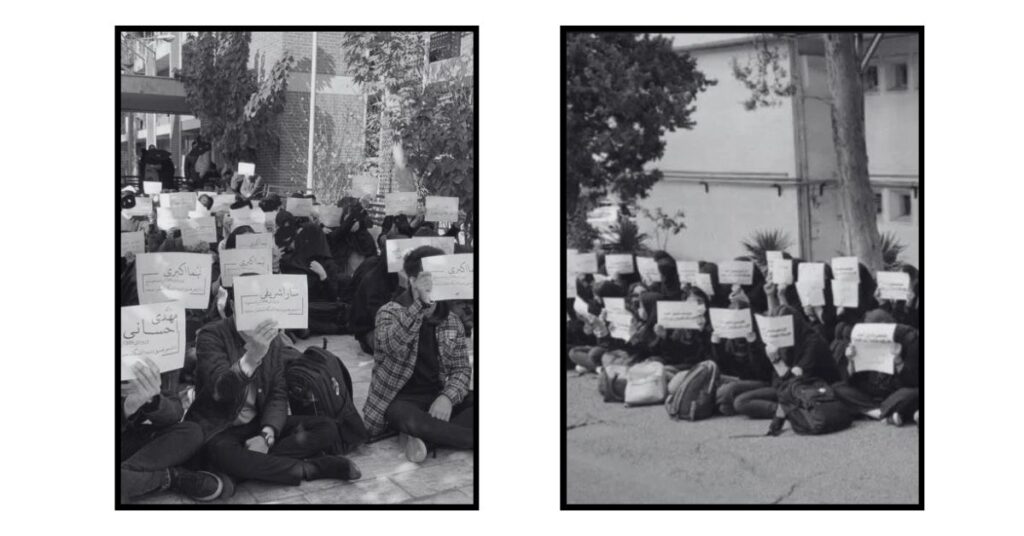
Hijab
Hijab is what got it all started, so naturally it is a symbol that helps Iranians show their political attitude. So when you see an Iranian women, for example, posting a photo of her without wearing a headscarf, it`s not just an everyday selfie, it`s a political statement. Women take off their scarves on social media, in the streets, sometimes at work and even in sport competitions (read the story of Iranian climber Elnaz Rekabi).
A significant part of protest of this kind is going on in social media. A few actresses and female filmmakers have posted their photos/videos without hijab supporting the movement. Why just a few? Because first things first, appearing without hijab brings an end to their career inside the country, and well, not everyone is ready to say goodbye to what they have been building all their lives. Moreover, some of them have been arrested. And who knows what accusation they may face.

Walking in the Street
A thing so basic, but presumably quite efficient. You might have heard that protests in the streets of Iran start in small groups and pop up here and there around town (they can even pop up inside subway!). This is done to decrease the risk of being crushed by the police. As far as protesting in the street posing certain risks for people, not everyone is ready or brave enough to start chanting anti-governmental slogans. That is why, some people just go for a walk around the city to join a protest when one pops up or at least be there and maybe help protesters somehow. On social media, Iranians post messages like “Isn`t the weather lovely for a walk?” or “I`ll go out for a walk today. Can`t miss the beautiful weather. Please, join me.” Now, you know what they are talking about.
Street Challenges
Taking a walk feels much better when you know that you are not alone. So young Iranians are trying to spread support and kindness whenever and however they can. Schoolgirls write little notes saying something like ‘Your hair has made the city nicer. Keep it up’; guys give women flowers in the street; some people offer a free hug to anyone who feels blue today (and those hugs are never segregated based on gender). Finally, there is a popular so-called fist challenge that has been popular on TikTok for a while, but went viral in Iran only after the protests had started. This is how ordinary things become political here.
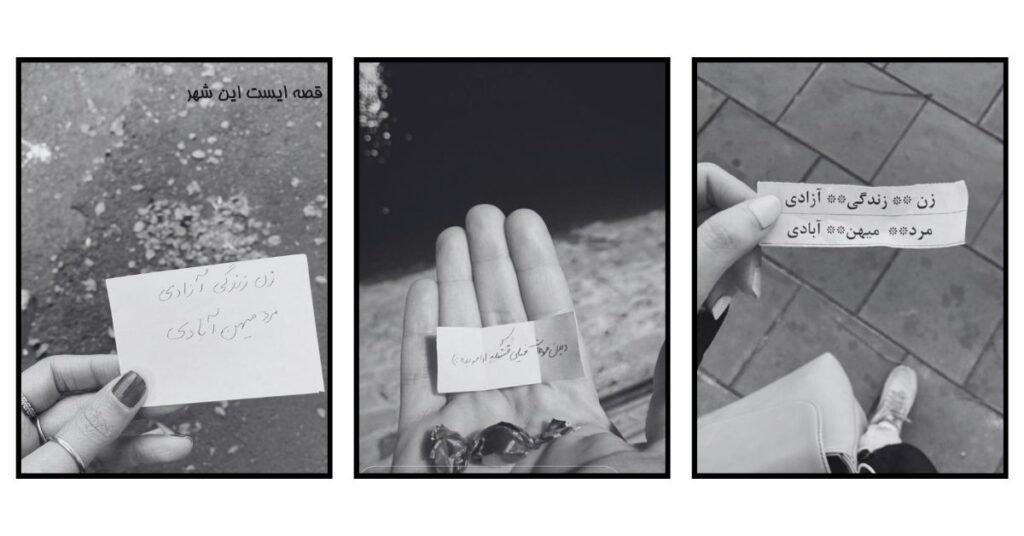
Honking the Horn / Creating Traffic Jams
Some people still do have to work and can`t afford joining the strike, so those who are in their car still support the movement by honking the horn while waiting at the red light or seeing a group of protesters in the street. Moreover, sometimes people create traffic in highways or main streets to prevent repressive forces from reaching the protesters.
Slogans
Slogans are probably the most obvious instrument of protests. Slogans are being chanted at protests, written on the walls, street signs (amazingly, you can see slogans written on street signs even way outside cities!), billboards and even on the floor. Of course, they are quite efficiently painted over, but people keep writing them over and over again.
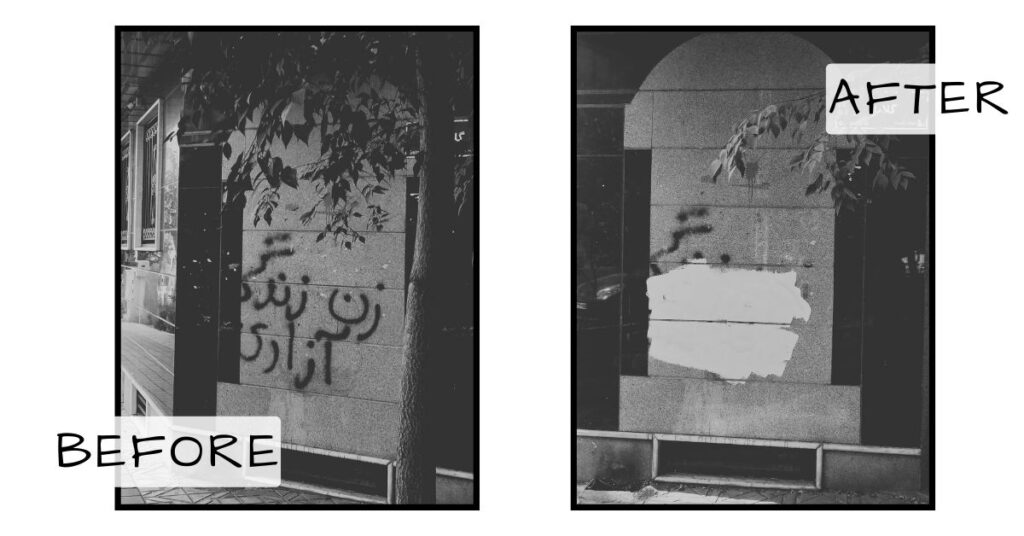
There is another way of using slogans, so unusual that couldn`t probably find it anywhere else. Each night at 9 pm Iranian go to the roof of their building (apartment building are mostly 3-5-storey) or open up a window and start chanting the slogans. The most incredible thing is that they manage to chant in perfect unison with people houses away from them! This is a very powerful feeling to hear people from this house chant the first part of a slogan, and people from another house continue it. This type of protest has been used since the 1979 revolution when people would chant ‘Allah Akbar!’ from their roofs. (The present movement resembles the 1979 revolution in many other aspects, too.)
Art
In the previous post, I have covered the movement-related art that can be easily found online and especially in social networks. Let`s now talk about art created in real life. Art students in major cities of Iran have expressed their protest in an artistic way. The main tool of most of them has been red paint symbolizing the blood of all the victims of the regime. For instance, in Yazd art students protested in the yard of their university with their hands covered in red paint, they stood around a fountain with its water turned red as well (interestingly, the idea of turning water in city fountains red has been used by the municipality for Moharram mourning days for years!) In other universities students poured red paint at chairs or left red hand marks on the walls of classrooms protesting against violence against students.
Boycott
It is proved that repressive forces use all the facilities they have access to. It is said that even ambulances are used these days to transport forces or arrested protesters, because ambulances can easily go through any kind of traffic and no one will even doubt about pulling aside to let it pass (but of course, with this information in hand, drivers don`t let ambulances pass that easily now, which can be be a bad thing in an emergency though). Now, one day a truck with a logo of a huge dairy company Mihan was seen carrying repressive forces. Infuriated by this, many Iranians stopped buying the produce of this company. The income of the company dropped so dramatically that just a few days later they made a video where workers asked were saying that nothing like that happened and this boycott harms ordinary workers in the first place.
People didn`t stop there and started boycotting more and more companies. Next, it was about online services like Digikala (Iranian Amazon) and Snapp (an Iranian Uber mixed with food & supermarket delivery). Then, companies that continued advertising on state television followed.
Autumn is normally the time for various cultural events, exhibitions, festivals. This year things are different. Elecomp, a popular IT and startup exhibition was going to be held in early October. However, just days before it, it was announced that Elecomp had been cancelled due to the low number of companies ready to participate. I believe, most IT companies were afraid that if they participated in this state-funded fair, they would be boycotted like Snapp and Digikala.
Tehran Short Film Festival also took place in October. It is state-funded too, and many filmmakers tried to pull their films out of it, with no success. The festival was held, but I suppose with little audience. The main series of festivals organized for the Day of the Islamic Revolution in February (they include theater, music, visual arts and film festivals) are still ahead of us, but I can already say that only a bunch of pro-governmental artists will attend.
Portraits of the Supreme Leader
I have already mentioned that the struggle is going on in schools as well, especially in schools for girls. In October social media was packed with videos of school girls tearing off pages with portraits of Khomeini (the founder of the Islamic Republic) from their school books (in case you didn`t know, each school book has his portrait on the first page) and then tearing them in pieces or walking on them. Also, you could see girls taking off their uniform scarves (called ‘maghnae’) in school (yes, even though it`s a girl school and there are no men inside, girls still have to wear proper hijab) and taking a group photo in front of portraits of Khomeini and Khamenei (with their backs to the camera, of course). However, since the violent repression of the disorder in one school, this way of protesting disappeared, because children`s safety is the priority.
And in the city, people would set billboards with Khamenei`s face on them on fire. Very soon though, most posters with his face were taken off to avoid being set on fire.
Not Paying Bills
Every day people are looking for new ways to make the government listen to their requests. More and more people are talking about weakening the income flow of the government. That is why, some people are insisting on not paying the bills, not doing any money transactions, buying less and less, and only the essentials. This method has shown its results already. The telecommunication company has recently increased monthly landline phone subscription by 10 times(!). And if you don`t pay for 15 months, you will use your phone number.
In conclusion, I would like to say that just like the movement itself, protesting methods keep evolving, and if the government continues repressing the protests and denies to listen to people`s voice, people will have to make their voice sound louder.



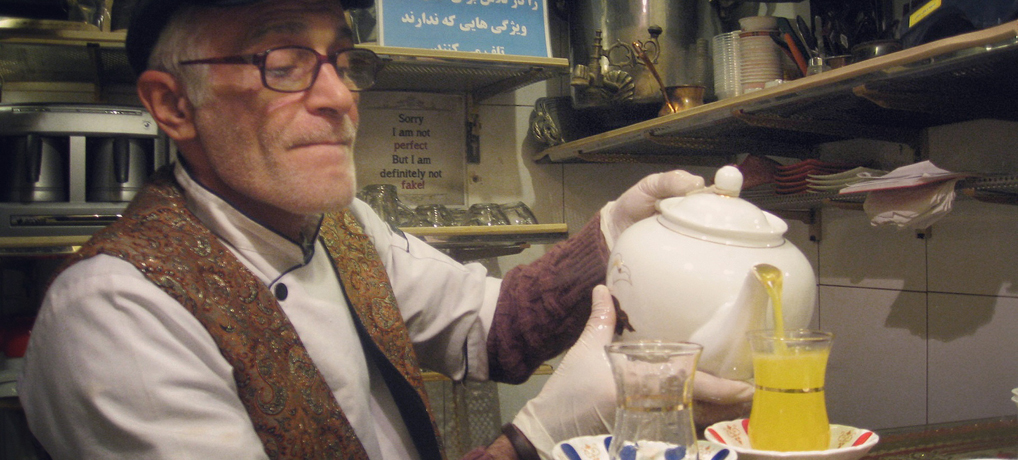

2 Comments
Maria
A very insightful post. We can only hope for a change and rely on people’s courage to continue the fight.
Katya
Thank you so much for your support!!!